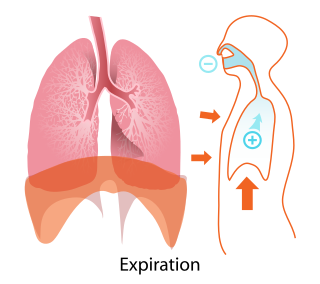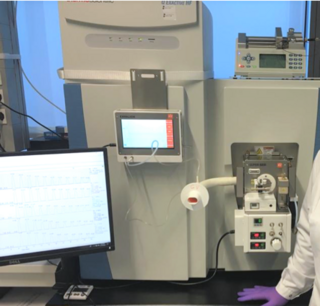Diffusing capacity of the lung (DL) measures the transfer of gas from air in the lung, to the red blood cells in lung blood vessels. It is part of a comprehensive series of pulmonary function tests to determine the overall ability of the lung to transport gas into and out of the blood. DL, especially DLCO, is reduced in certain diseases of the lung and heart. DLCO measurement has been standardized according to a position paper by a task force of the European Respiratory and American Thoracic Societies.
Dead space is the volume of air that is inhaled that does not take part in the gas exchange, because it either remains in the conducting airways or reaches alveoli that are not perfused or poorly perfused. It means that not all the air in each breath is available for the exchange of oxygen and carbon dioxide. Mammals breathe in and out of their lungs, wasting that part of the inhalation which remains in the conducting airways where no gas exchange can occur.

Exhalation is the flow of the breath out of an organism. In animals, it is the movement of air from the lungs out of the airways, to the external environment during breathing. This happens due to elastic properties of the lungs, as well as the internal intercostal muscles which lower the rib cage and decrease thoracic volume. As the thoracic diaphragm relaxes during exhalation it causes the tissue it has depressed to rise superiorly and put pressure on the lungs to expel the air. During forced exhalation, as when blowing out a candle, expiratory muscles including the abdominal muscles and internal intercostal muscles generate abdominal and thoracic pressure, which forces air out of the lungs.
Volatile organic compounds (VOCs) are organic compounds that have a high vapor pressure at room temperature. High vapor pressure correlates with a low boiling point, which relates to the number of the sample's molecules in the surrounding air, a trait known as volatility.

Selected-ion flow-tube mass spectrometry (SIFT-MS) is a quantitative mass spectrometry technique for trace gas analysis which involves the chemical ionization of trace volatile compounds by selected positive precursor ions during a well-defined time period along a flow tube. Absolute concentrations of trace compounds present in air, breath or the headspace of bottled liquid samples can be calculated in real time from the ratio of the precursor and product ion signal ratios, without the need for sample preparation or calibration with standard mixtures. The detection limit of commercially available SIFT-MS instruments extends to the single digit pptv range.

A breathalyzer or breathalyser, also called an alcohol meter, is a device for measuring breath alcohol content (BrAC). It is commonly utilized by law enforcement officers whenever they initiate traffic stops. The name is a genericized trademark of the Breathalyzer brand name of instruments developed by inventor Robert Frank Borkenstein in the 1950s.

An electronic nose is an electronic sensing device intended to detect odors or flavors. The expression "electronic sensing" refers to the capability of reproducing human senses using sensor arrays and pattern recognition systems.

Proton-transfer-reaction mass spectrometry (PTR-MS) is an analytical chemistry technique that uses gas phase hydronium reagent ions which are produced in an ion source. PTR-MS is used for online monitoring of volatile organic compounds (VOCs) in ambient air and was developed in 1995 by scientists at the Institut für Ionenphysik at the Leopold-Franzens University in Innsbruck, Austria. A PTR-MS instrument consists of an ion source that is directly connected to a drift tube and an analyzing system. Commercially available PTR-MS instruments have a response time of about 100 ms and reach a detection limit in the single digit pptv or even ppqv region. Established fields of application are environmental research, food and flavor science, biological research, medicine, security, cleanroom monitoring, etc.
Exhaled breath analysis is a method in medicine for gaining information on the clinical state of an individual by monitoring the components present in the exhaled breath.

Breathing is the rhythmical process of moving air into (inhalation) and out of (exhalation) the lungs to facilitate gas exchange with the internal environment, mostly to flush out carbon dioxide and bring in oxygen.
Exhaled breath condensate (EBC) is the exhalate from breath, that has been condensed, typically via cooling using a collection device. EBC reflects changes in the respiratory fluid that lines the airways and is an inexpensive, non-invasive tool that has potential for scientific research. Despite its promises, it has not been proven for screening or diagnosing diseases of the lung and other conditions, yet. It has long been appreciated that the exhaled breath is saturated by water vapour, but using it for studies of the lung was probably first described in the Russian scientific literature.
Anton Amann was an Austrian chemist and Professor of chemistry at the Innsbruck Medical University. He worked in the area of physical chemistry, ECG analysis, and exhaled breath analysis.
Breath diagnostics involves the analysis of a sample of human breath to monitor, diagnose, and detect diseases and conditions. Besides its primary constituents – nitrogen, oxygen, carbon dioxide and water vapour – exhaled human breath contains over one thousand other compounds at trace levels. Many of these species are formed as the by-products of metabolic processes and can be indicative of a number of different diseases and conditions. Examples of such biomarkers are outlined below:
Analytical thermal desorption, known within the analytical chemistry community simply as "thermal desorption" (TD), is a technique that concentrates volatile organic compounds (VOCs) in gas streams prior to injection into a gas chromatograph (GC). It can be used to lower the detection limits of GC methods, and can improve chromatographic performance by reducing peak widths.
Volatolomics is a branch of chemistry that studies volatile organic compounds (VOCs) emitted by a biological system, under specific experimental conditions.
The volatilome contains all of the volatile metabolites as well as other volatile organic and inorganic compounds that originate from an organism, super-organism, or ecosystem. The atmosphere of a living planet could be regarded as its volatilome. While all volatile metabolites in the volatilome can be thought of as a subset of the metabolome, the volatilome also contains exogenously derived compounds that do not derive from metabolic processes, therefore the volatilome can be regarded as a distinct entity from the metabolome. The volatilome is a component of the 'aura' of molecules and microbes that surrounds all organisms.

In an oil and gas production, flash-gas is a spontaneous vapor that is produced from the heating or depressurization of the extracted oil mixture during different phases of production. Flash evaporation, or flashing, is the process of volatile components suddenly vaporizing from their liquid state. This often happens during the transportation of petroleum products through pipelines and into vessels, such as when the stream from a common separation unit flows into an on-site atmospheric storage tank. Vessels that are used to intentionally “flash” a mixture of gas and saturated liquids are aptly named "flash drums." A type of vapor-liquid separator. A venting apparatus is used in these vessels to prevent damage due to increasing pressure, extreme cases of this are referred to as boiling liquid expanding vapor explosion (BLEVE).

Secondary electro-spray ionization (SESI) is an ambient ionization technique for the analysis of trace concentrations of vapors, where a nano-electrospray produces charging agents that collide with the analyte molecules directly in gas-phase. In the subsequent reaction, the charge is transferred and vapors get ionized, most molecules get protonated and deprotonated. SESI works in combination with mass spectrometry or ion-mobility spectrometry.

A coronavirus breathalyzer is a diagnostic medical device enabling the user to test with 90% or greater accuracy the presence of severe acute respiratory syndrome coronavirus 2 in an exhaled breath. As of the first half of 2020, the idea of a practical coronavirus breathalyzer was concomitantly developed by unrelated research groups in Australia, Canada, Finland, Germany, Indonesia, Israel, Netherlands, Poland, Singapore, United Kingdom and USA.
Smell as evidence of disease has been long used, dating back to Hippocrates around 400 years BCE. It is still employed with a focus on volatile organic compounds (VOCs) found in body odor. VOCs are carbon-based molecular groups having a low molecular weight, secreted during cells' metabolic processes. Their profiles may be altered by diseases such as cancer, metabolic disorders, genetic disorders, infections, and among others. Abnormal changes in VOC composition can be identified through equipment such as gas chromatography-mass spectrometry(GC-MS), electronic nose (e-noses), and trained non-human olfaction.

















